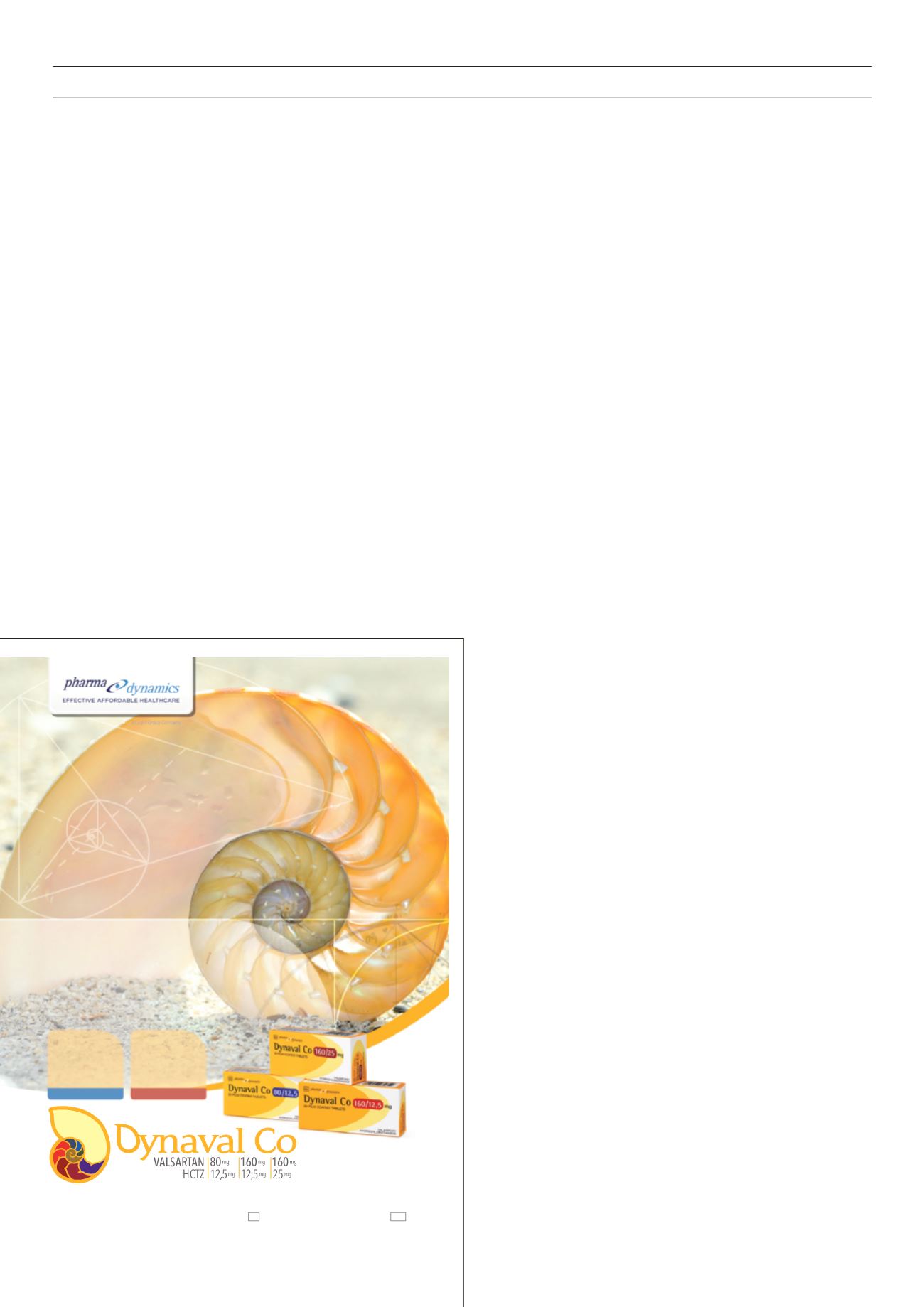

RESEARCH ARTICLE
SA JOURNAL OF DIABETES & VASCULAR DISEASE
32
VOLUME 14 NUMBER 1 • JULY 2017
Moreover, according to the studies of Morricone, Empana and
Zhang, which were published in 1999, 2004 and 2008, respectively,
abdominal adiposity and severity of CAD were correlated.
12-14
Although their findings were similar to ours regarding correlation
between WHR/abdominal obesity and severity of CAD, they did not
compare BMI with WHR regarding their impact on the severity of
CAD, as we did. These studies showed that, first, high BMI per se was
not a risk factor for CAD, and second, high WHR/abdominal obesity
was a risk factor for CAD. That means abdominal fat accumulation
is more pathological (adiposopathic) than subcutaneous fat
accumulation.
19,24
Although in our study, regression analysis for confounding
factors such as DM, HTN, cigarette smoking and hyperlipidaemia
revealed a statistically significant correlation between them and the
severity of CAD (
p
= 0.002,
p
= 0.001,
p
= 0.04 and
p
= 0.02,
respectively), after omission of confounding factors, there was
still a paradoxical relationship between BMI and severity of CAD.
β
-coefficients before multivariate analysis were –0.2 and –0.18,
and after multivariate analysis they were –0.17 and –0.14, based on
the SYNTAX and Duke scores, respectively. This showed an inverse
relationship between BMI and severity of CAD.
The limitation of our study was that lower BMI (20–24 kg/m
2
)
was more prevalent (56.2%) in the older age groups (> 60 years),
and higher BMI (30–34 kg/m
2
) was more common (57.8%) in the
younger age groups (40–59 years). As in the study by Niraj
et al
.,
11
it can be concluded that patents with a higher BMI have been
evaluated earlier for CAD. This indicates a need for a larger study
with more age-matched groups.
Conclusion
The findings of this study, paradoxically, showed a negative
correlation between BMI and the severity of CAD, but a positive
correlation between WHR and the severity of CAD.
References
1.
Eckel RH. Obesity and heart disease: a statement for healthcare professionals from
the nutrition committee, American Heart Association.
Circulation
1997;
96
: 3248–
3250.
2.
Krauss RM, Winston M, Fletcher RN, Grundy SM. Obesity: impact of cardiovascular
disease.
Circulation
1998;
98
: 1472–1476.
3.
Hubert HB, Feinleib M, McNamara PM, Castelli WP. Obesity as an independent
risk factor for cardiovascular disease: a 26-year follow up of participants in the
Framingham Heart Study.
Circulation
1983;
67
: 968–977.
4.
27th Bethesda conference. Matching the intensity of risk factor management with
the hazard for coronary disease events. September 14–15, 1995.
J Am Coll Cardiol
1996;
27
: 957–1047.
5.
Jousilahti P, Tuomilehto J, Vartiainen E, Pekkanen J, Puska P. Body weight,
cardiovascular risk factors, and coronary mortality. 15-year follow up of middle-
aged men and women in eastern Finland.
Circulation
1996;
93
: 1372–1379.
6.
Schulte H, Cullen P, Assmann G. Obesity, mortality and cardiovascular disease in the
Munster Heart Study (PROCAM).
Atherosclerosis
1999;
144
: 199–209.
7.
Manson JE, Willett WC, Stampfer MJ, Colditz GA, Hunter DJ, Hankinson SE,
et al
.
Body weight and mortality among women.
N Engl J Med
1995;
333
: 677–685.
8.
Garrison RJ, Castelli WP. Weight and thirty-year mortality of men in the Framingham
study.
Ann Inter Med
1985;
103
: 1006–1009.
9. Calle EE, Thun MJ, Peterlli JM, Rodriguez C, Heath CW Jr. Body mass index and
mortality in a prospective cohort of US adults.
N Engl J Med
1999;
341
: 1097–
1105.
10. Niraj A, Pradaham JT, Fakhri H, Veeranna V, Afonsoo L. Severity of coronary artery
disease in obese patients undergoing coronary angiography: “obesity paradox”.
Clin Cardiol
2007;
30
: 391–396.
11. Rubinshtein R, Halon DA. Relation between obesity and severity of coronary artery
disease.
Am J Cardiol
2006;
97
: 1277–1280.
12. Morricone L, Ferrari M, Enrini R, Inglese L, Giardini D, Garancini P, Caviezel F. The
role of central fat distribution in coronary artery disease in obesity: comparison of
nondiabetic obese, diabetic obese, and normal weight subjects.
Int J Obesity
1999;
23
: 1129–1135.
13. Empana JP, Ducimetiere P, Charles MA, Jouven X. Sagittal abdominal diameter an
risk of sudden death in asymptomatic middle-aged men in Paris Prospective Study
I.
Circulation
2004;
110
: 2781–2785.
14. Zhang C, Rexrode KM, van Darm RM, Li TY, Hu, FB. Abdominal obesity and the risk
of all-cause, cardiovascular, and cancer mortality: sixteen years of follow-up in US
women.
Circulation
2008;
117
: 1658–1667.
15. Sianos G, Morel MA, Kappetein AP,
et al
. The Syntax score: an angiographic
tool grading the complexity of coronary artery disease.
Euro Intervent
2005;
1
: 219–227.
16. Kem M.What is SYNTAX score and how should we use it.
Cath Lab Digest
2009;
17
: 4–8.
17. Dash H, Johnson RA, Dinsmore RE,
et al
. Cardiomyopathic syndrome due to
coronary artery disease: relation to angiographic extent of coronary disease and to
remote myocardial infarction.
Br Heart J
1977;
39
: 733–739.
18. Califf RM, Philips HR, Hindman MC,
et al
. Prognostic value of a coronary artery
jeopardy score.
J Am Coll Cardiol
1985;
5
(5): 1055–1063.
19. Bays HE. Adiposopathy: Is “sick fat” a cardiovascular disease?
J Am Coll Cardiol
2011;
57
: 2461–2473.
20. Snijder MB, van Dam RM, Visser M, Seidell JC. What aspects of body fat are
particularly hazardous and how do we measure them?
Int J Epidemiol
2006;
34
:
83–92.
21. Tchernof A, Nolan A, Sites CK, Ades PA, Poehlman ET. Weight loss reduces
C-reactive protein levels in obese postmenopausal women.
Circulation
2002;
105
:
564–569.
22. Ziccardi P, Nappo F, Giugliano G, Esposito K, Marfella R, Cioffi M,
et al
. Reduction
of inflammatory cytokine concentration and improvement of endothelial function
in obese women after weight loss over one year.
Circulation
2002;
105
: 804–809.
23. Bays H, Ballantyne C. Adiposopathy: why do adiposity and obesity cause metabolic
disease?
Future Lipidol
2006;
1
: 389–420.
24. Bays HE, Gonzalez-Campoy JM, Bray GA, Kitachi AE, Bergman DA, Schort AB,
et
al
. Pathogenic potential of adipose tissue and metabolic consequences of adipocyte
hypertrophy and increase visceral adiposity.
Expert Rev Cardiovasc Ther
2008;
6
:
343–368.
DYNAVAL CO
80/12,5, 160/12,5, 160/25 mg. Each tablet contains 80, 160, 160 mg valsartan respectively
and 12,5, 12,5, 25 mg hydrochlorothiazide respectively. S3 A44/7.1.3/0018, 0019, 0020. NAM NS2
14/7.1.3/0061, 0062, 0063. For full prescribing information, refer to the package insert approved by the
MedicinesControlCouncil,19April2013.
1)
BlackHR,
etal.
Valsartan.More thanadecadeofexperience.Drugs
2009;69(17):2393-2414.
2)
Database of Medicine Prices (14 March 2017). Department of Health website.
http://www.mpr.gov.za- Accessed on 30 March 2017.
3)
IMS MAT UNITS Dec 2016.
DLCH393/04/2017.
CUSTOMER CARE LINE
0860 PHARMA (742 762)
www.pharmadynamics.co.zaDesigned
to protect
In addition to
efficacy
,
safety
and
proven outcomes
,
valsartan
1
:
đŏ %/ŏ!ûŏ! 0%2!ŏ !5+* ŏ0$!ŏĂąŏ$+1.ŏ +/%*#ŏ%*0!.2 (
đŏ !(%2!./ŏ/)++0$ŏ ŏ +*0.+(
đŏ )%)% /ŏ0$!ŏ %. % *ŏ.$50$)
đŏ 00!*1 0!/ŏ0$!ŏ*!# 0%2!ŏ!ûŏ! 0/ŏ+"ŏ$5 .+ $(+.+0$% 6% !
COST SAVING
2
UP TO
vs the originator
65%
COST SAVING
2
UP TO
vs the market leader
3
43%
’S
30
PACKED IN



















